brake light Lexus GS350 2007 Using the interior lights / LEXUS 2007 GS430/350 OWNER'S MANUAL (OM30A04U)
[x] Cancel search | Manufacturer: LEXUS, Model Year: 2007, Model line: GS350, Model: Lexus GS350 2007Pages: 562
Page 2 of 562
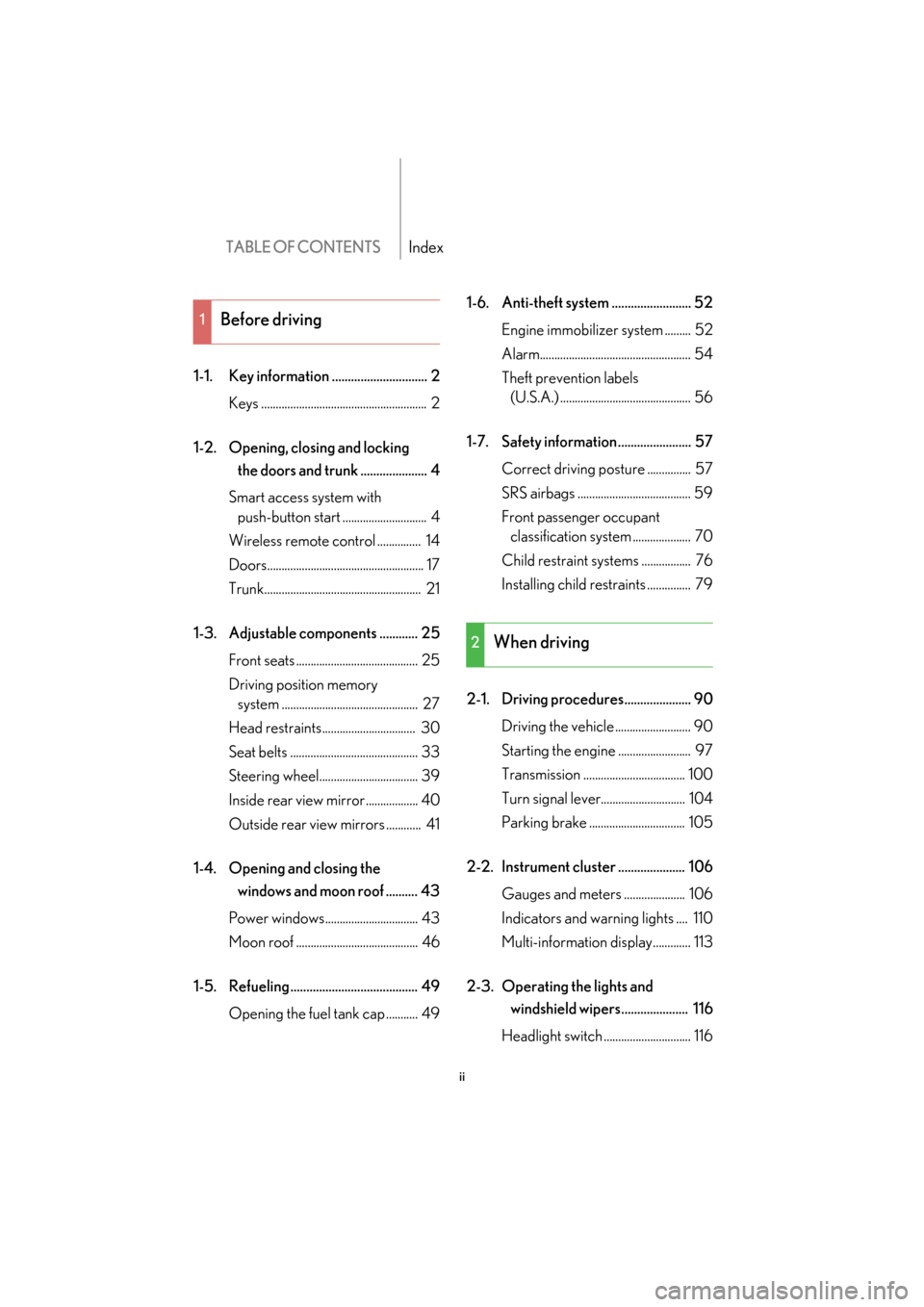
TABLE OF CONTENTSIndex
ii
1-1. Key information .............................. 2Keys ......................................................... 2
1-2. Opening, closing and locking
the doors and trunk ..................... 4
Smart access system with push-button start ............................. 4
Wireless remote control ............... 14
Doors...................................................... 17
Trunk...................................................... 21
1-3. Adjustable components ............ 25 Front seats .......................................... 25
Driving position memory
system ............................................... 27
Head restraints................................ 30
Seat belts ............................................ 33
Steering wheel.................................. 39
Inside rear view mirror .................. 40
Outside rear view mirrors ............ 41
1-4. Opening and closing the
windows and moon roof .......... 43
Power windows................................ 43
Moon roof .......................................... 46
1-5. Refueling ........................................ 49 Opening the fuel tank cap ........... 49 1-6. Anti-theft system ......................... 52
Engine immobilizer system ......... 52
Alarm.................................................... 54
Theft prevention labels
(U.S.A.) ............................................. 56
1-7. Safety information ....................... 57 Correct driving posture ............... 57
SRS airbags ....................................... 59
Front passenger occupant
classification system .................... 70
Child restraint sy stems ................. 76
Installing child restraints ............... 79
2-1. Driving procedures..................... 90 Driving the vehicle .......................... 90
Starting the engine ......................... 97
Transmission ................................... 100
Turn signal lever............................. 104
Parking brake ................................. 105
2-2. Instrument cluster ..................... 106 Gauges and meters ..................... 106
Indicators and warning lights .... 110
Multi-information display............. 113
2-3. Operating the lights and
windshield wipers..................... 116
Headlight switch .............................. 116
1Before driving
2When driving
Page 12 of 562
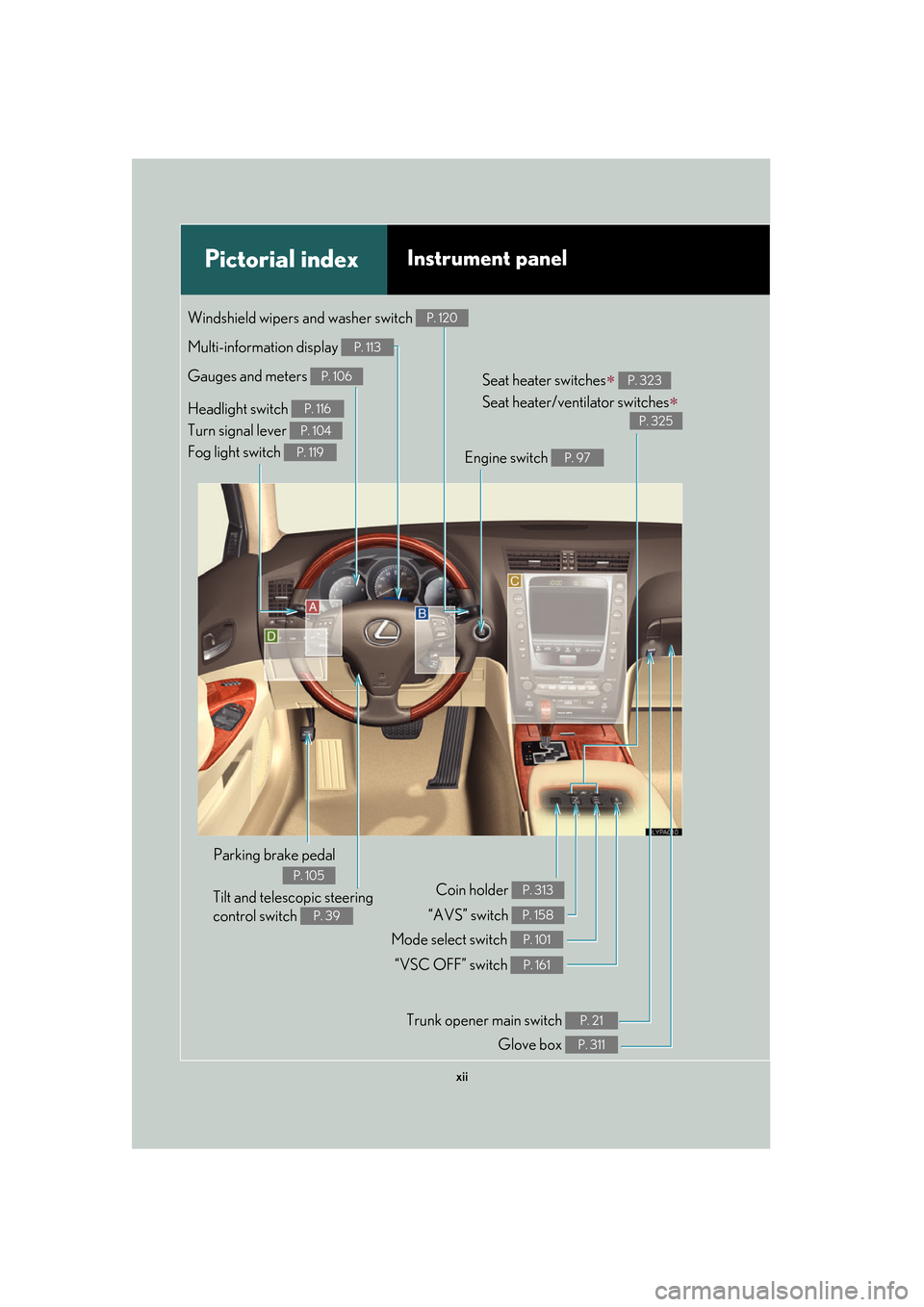
xii
Pictorial indexInstrument panel
Headlight switch
Turn signal lever
Fog light switch P. 116
P. 104
P. 119
Gauges and meters P. 106
Multi-information display P. 113
Windshield wipers and washer switch P. 120
Engine switch P. 97
Trunk opener main switch P. 21
Glove box P. 311
Seat heater switches
Seat heater/ventilator switches
P. 323
P. 325
Tilt and telescopic steering
control switch
P. 39
Parking brake pedal
P. 105
“VSC OFF” switch P. 161
Coin holder P. 313
Mode select switch P. 101
“AVS” switch P. 158
Page 109 of 562
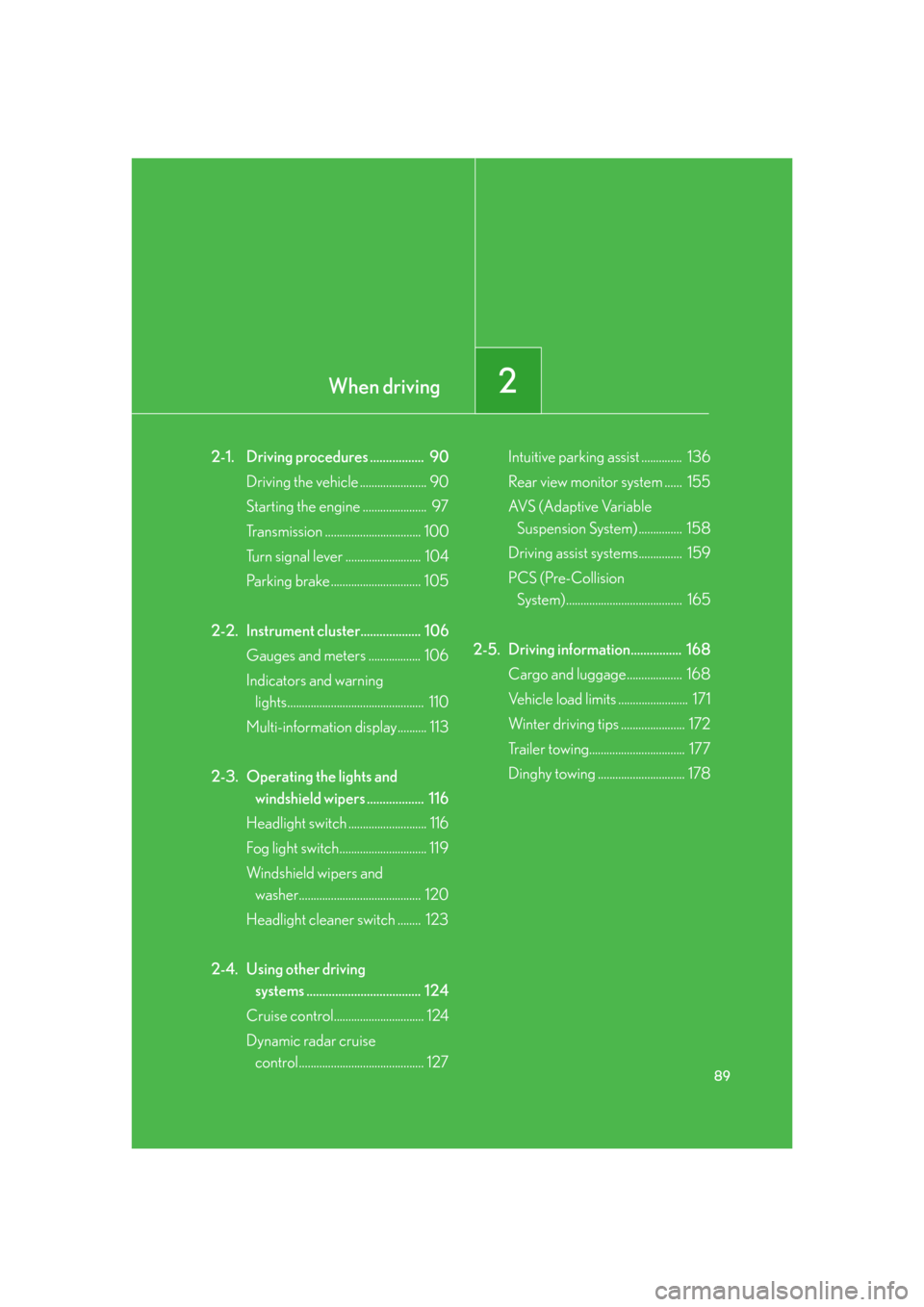
When driving2
89
2-1. Driving procedures ................. 90Driving the vehicle ....................... 90
Starting the engine ...................... 97
Transmission ................................. 100
Turn signal lever .......................... 104
Parking brake ............................... 105
2-2. Instrument cluster................... 106 Gauges and meters .................. 106
Indicators and warning
lights............................................... 110
Multi-information display.......... 113
2-3. Operating the lights and
windshield wipers .................. 116
Headlight switch ........................... 116
Fog light switch.............................. 119
Windshield wipers and
washer.......................................... 120
Headlight cleaner switch ........ 123
2-4. Using other driving
systems .................................... 124
Cruise control............................... 124
Dynamic radar cruise
control........................................... 127 Intuitive parking assist .............. 136
Rear view monitor system ...... 155
AVS (Adaptive Variable
Suspension System) ............... 158
Driving assist systems............... 159
PCS (Pre-Collision
System)........................................ 165
2-5. Driving information................ 168 Cargo and luggage................... 168
Vehicle load limits ........................ 171
Winter driving tips ...................... 172
Trailer towing................................. 177
Dinghy towing .............................. 178
Page 114 of 562
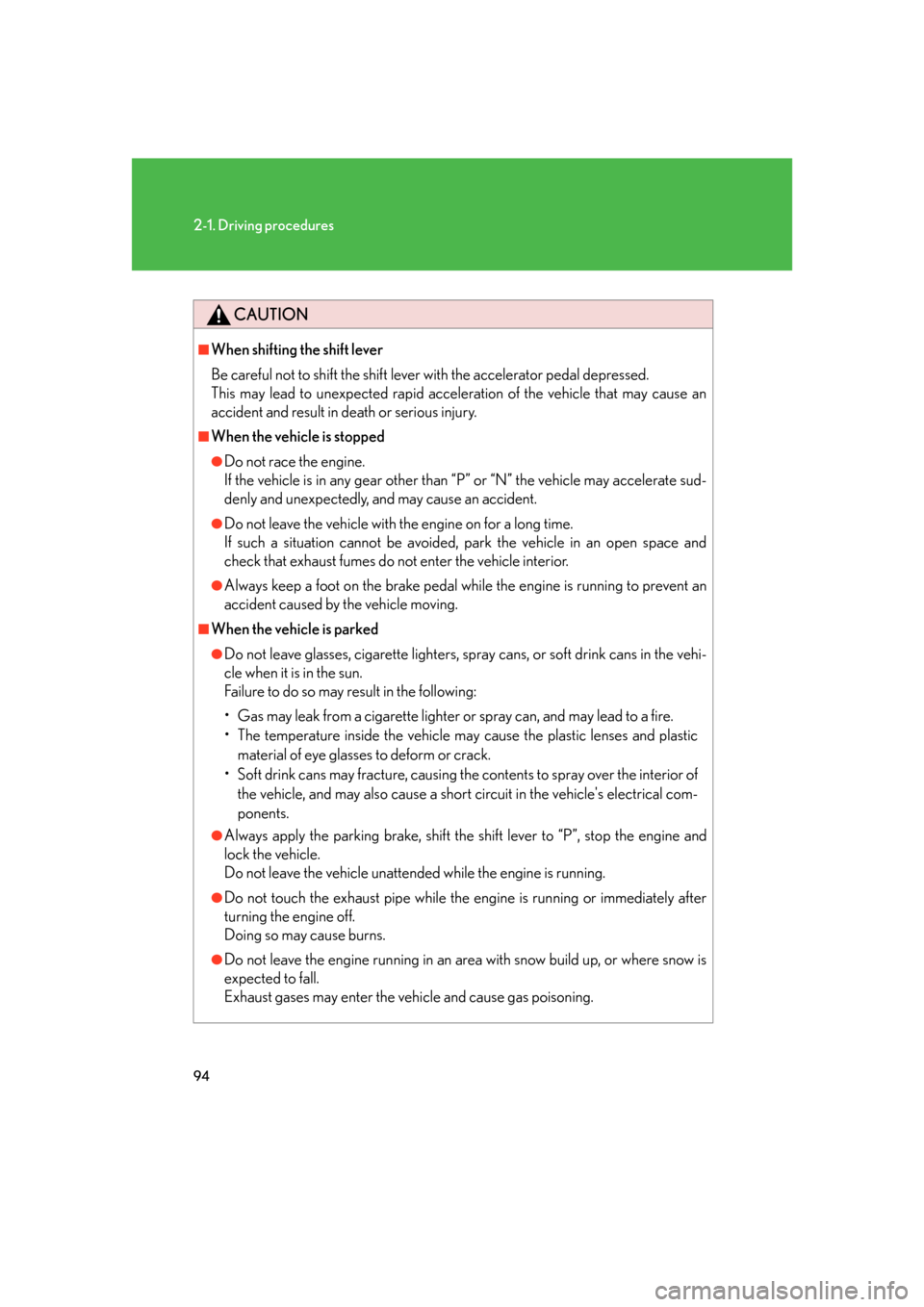
94
2-1. Driving procedures
CAUTION
■When shifting the shift lever
Be careful not to shift the shift lever with the accelerator pedal depressed.
This may lead to unexpected rapid acceleration of the vehicle that may cause an
accident and result in death or serious injury.
■When the vehicle is stopped
●Do not race the engine.
If the vehicle is in any gear other than “P” or “N” the vehicle may accelerate sud-
denly and unexpectedly, and may cause an accident.
●Do not leave the vehicle with the engine on for a long time.
If such a situation cannot be avoided, park the vehicle in an open space and
check that exhaust fumes do no t enter the vehicle interior.
●Always keep a foot on the brake pedal while the engine is running to prevent an
accident caused by the vehicle moving.
■When the vehicle is parked
●Do not leave glasses, cigarette lighters, spray cans, or soft drink cans in the vehi-
cle when it is in the sun.
Failure to do so may result in the following:
• Gas may leak from a cigarette lighter or spray can, and may lead to a fire.
• The temperature inside the vehicle may cause the plastic lenses and plastic material of eye glasses to deform or crack.
• Soft drink cans may fracture, causing the contents to spray over the interior of the vehicle, and may also cause a short circuit in the vehicle's electrical com-
ponents.
●Always apply the parking brake, shift the shift lever to “P”, stop the engine and
lock the vehicle.
Do not leave the vehicle unattend ed while the engine is running.
●Do not touch the exhaust pipe while the engine is running or immediately after
turning the engine off.
Doing so may cause burns.
●Do not leave the engine running in an area with snow build up, or where snow is
expected to fall.
Exhaust gases may enter the vehicle and cause gas poisoning.
Page 137 of 562
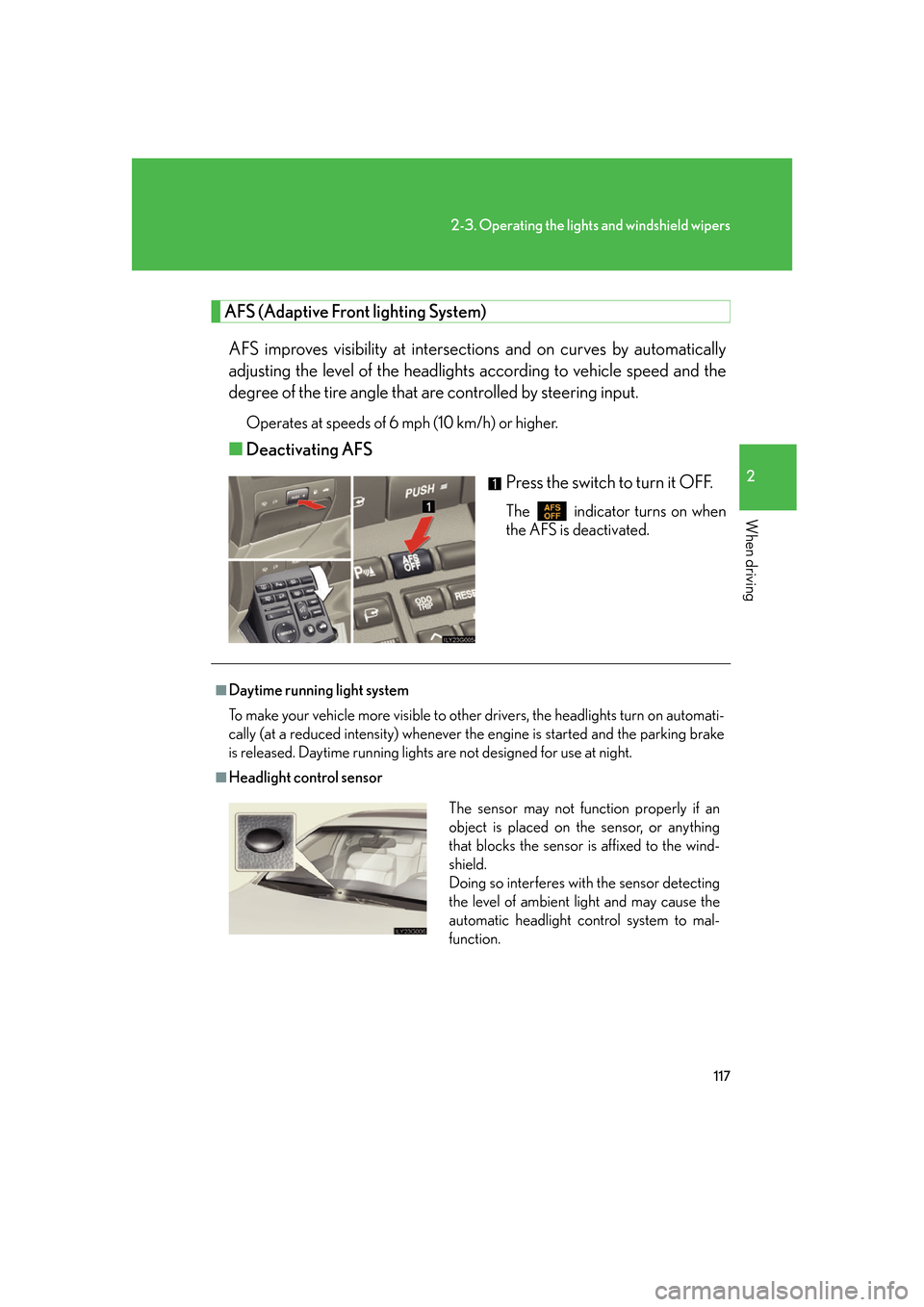
117
2-3. Operating the lights and windshield wipers
2
When driving
AFS (Adaptive Front lighting System)
AFS improves visibility at intersectio ns and on curves by automatically
adjusting the level of the headlights according to vehicle speed and the
degree of the tire angle that are controlled by steering input.
Operates at speeds of 6 mph (10 km/h) or higher.
■ Deactivating AFS
Press the switch to turn it OFF.
The indicator turns on when
the AFS is deactivated.
■Daytime running light system
To make your vehicle more visible to other drivers, the headlights turn on automati -
cally (at a reduced intensity) whenever the engine is started and the parking brake
is
released. Daytime running lights are not designed for use at night.
■Headlight control sensor
The sensor may not function properly if an
object is placed on the sensor, or anything
that blocks the sensor is affixed to the wind-
shield.
Doing so interferes with the sensor detecting
the level of ambient light and may cause the
automatic headlight control system to mal-
function.
Page 145 of 562
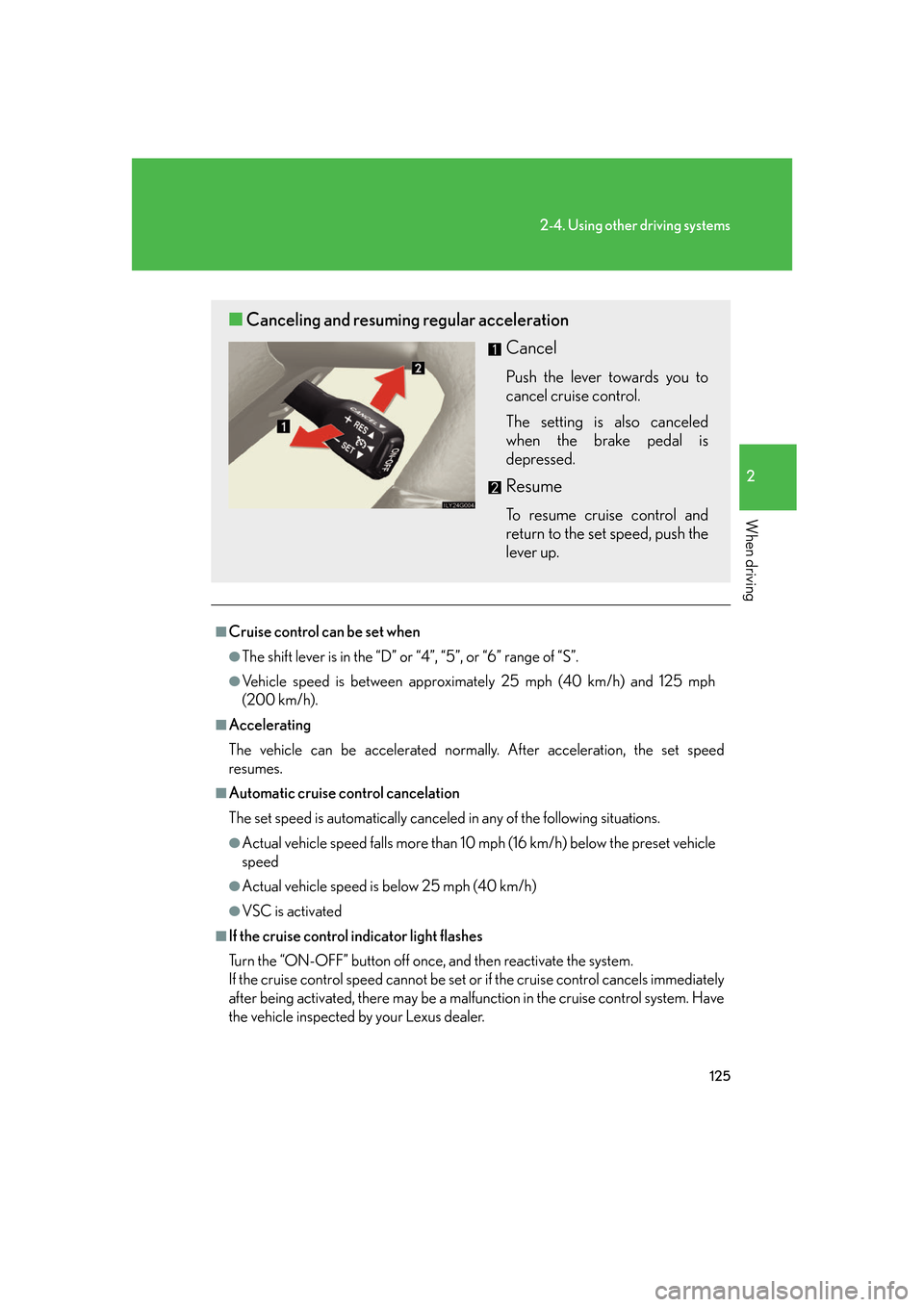
125
2-4. Using other driving systems
2
When driving
■Cruise control can be set when
●The shift lever is in the “D” or “4”, “5”, or “6” range of “S”.
●Vehicle speed is between approximately 25 mph (40 km/h) and 125 mph
(200 km/h).
■Accelerating
The vehicle can be accelerated normally. After acceleration, the set speed
r
esumes.
■Automatic cruise control cancelation
The set speed is automatically canceled in any of the following situations.
●Actual vehicle speed falls more than 10 mph (16 km/h) below the preset vehicle
speed
●Actual vehicle speed is below 25 mph (40 km/h)
●VSC is activated
■If the cruise control indicator light flashes
Turn the “ON-OFF” button off once, and
then reactivate the system.
If the cruise control speed cannot be set or i
f the cruise control cancels immediately
after being activated, there may be a malfun ction in the cruise control system. Have
the vehicle inspected by your Lexus dealer.
■ Canceling and resuming regular acceleration
Cancel
Push the lever towards you to
cancel cruise control.
The setting is also canceled
when th
e brake pedal is
depressed.
Resume
To resume cruise control and
return to the set speed, push the
lever up.
Page 148 of 562
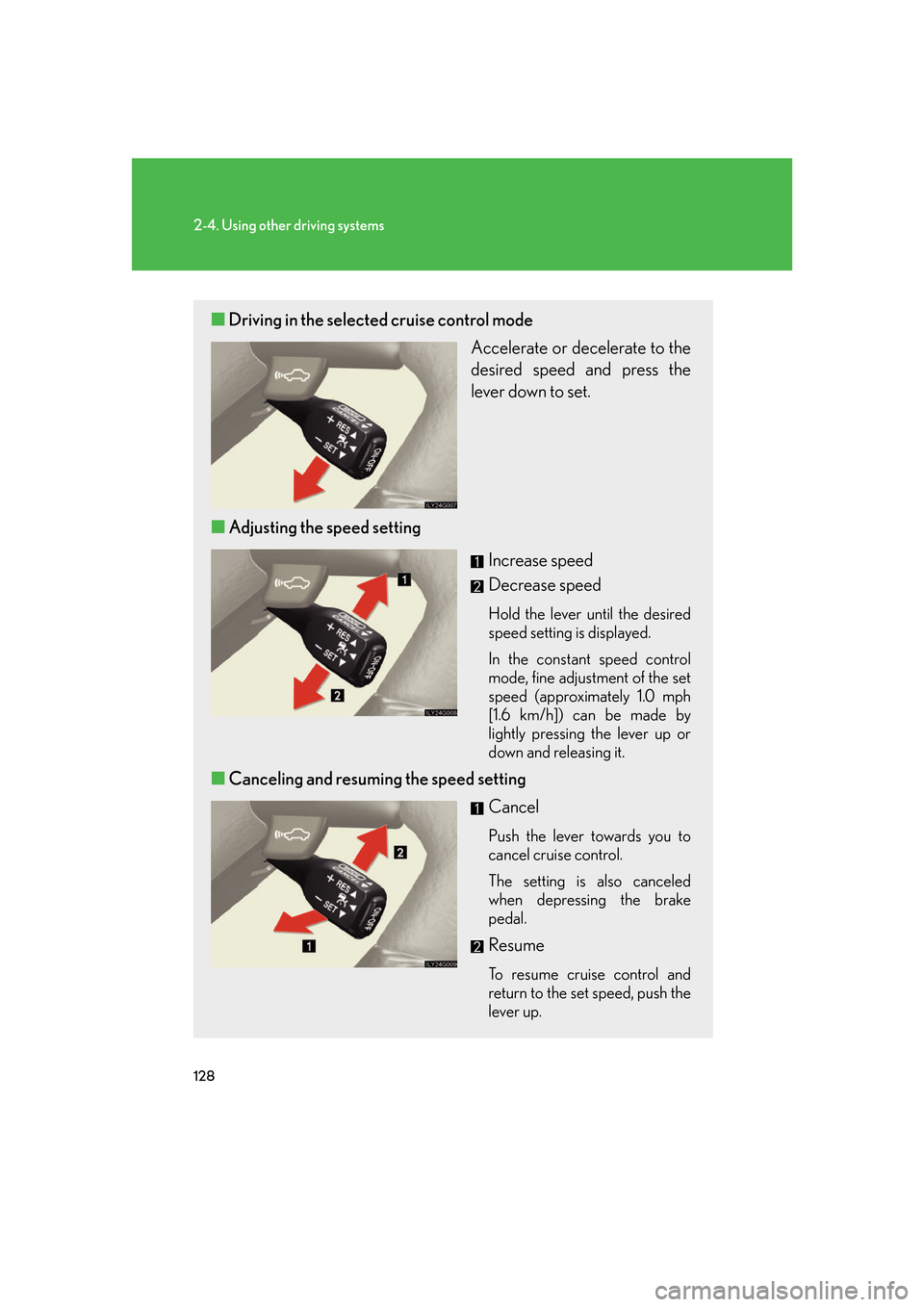
128
2-4. Using other driving systems
■Driving in the selected cruise control mode
Accelerate or decelerate to the
desired speed and press the
lever down to set.
■ A
djusting the speed setting
Increase speed
Decrease speed
Hold the lever until the desired
speed setting is displayed.
In the constant speed control
mode,
fine adjustment of the set
speed (approximately 1.0 mph
[1.6 km/h]) can be made by
lightly pressing the lever up or
down and releasing it.
■ Canceling and resuming the speed setting
Cancel
Push the lever towards you to
cancel cruise control.
The setting is also canceled
when depr
essing the brake
pedal.
Resume
To resume cruise control and
return to the set speed, push the
lever up.
Page 180 of 562
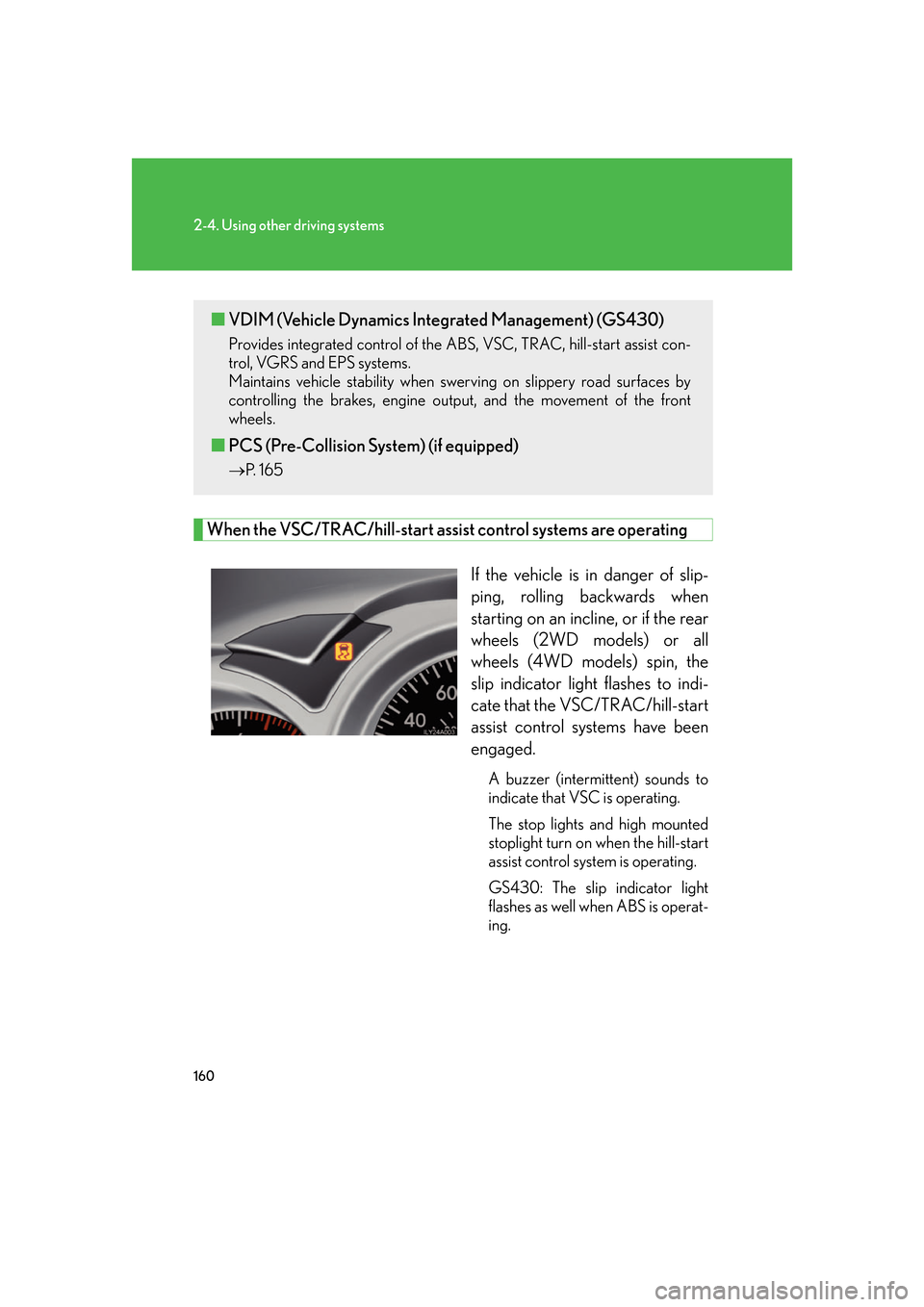
160
2-4. Using other driving systems
When the VSC/TRAC/hill-start assist control systems are operating
If the vehicle is in danger of slip-
ping, rolling backwards when
star
ting on an incli ne, or if the rear
wheels (2WD models) or all
wheels (4WD models) spin, the
slip indicator light flashes to indi-
cate that the VSC/TRAC/hill-start
as
sist control systems have been
engaged.
A buzzer (intermittent) sounds to
indicate that VSC is operating.
The stop lights and high mounted
stoplight turn on when the hill-star
t
assist control system is operating.
GS430: The slip indicator light
flashes as w
ell when ABS is operat -
ing.
■VDIM (Vehicle Dynamics Integ rated Management) (GS430)
Provides integrated control of the AB S, VSC, TRAC, hill-start assist con-
trol, VGRS and EPS systems.
Maintains vehicle stability when swerving on slippery road surfaces by
contr
olling the brakes, engine output, and the movement of the front
wheels.
■ PCS (Pre-Collision System) (if equipped)
P. 1 6 5
Page 182 of 562
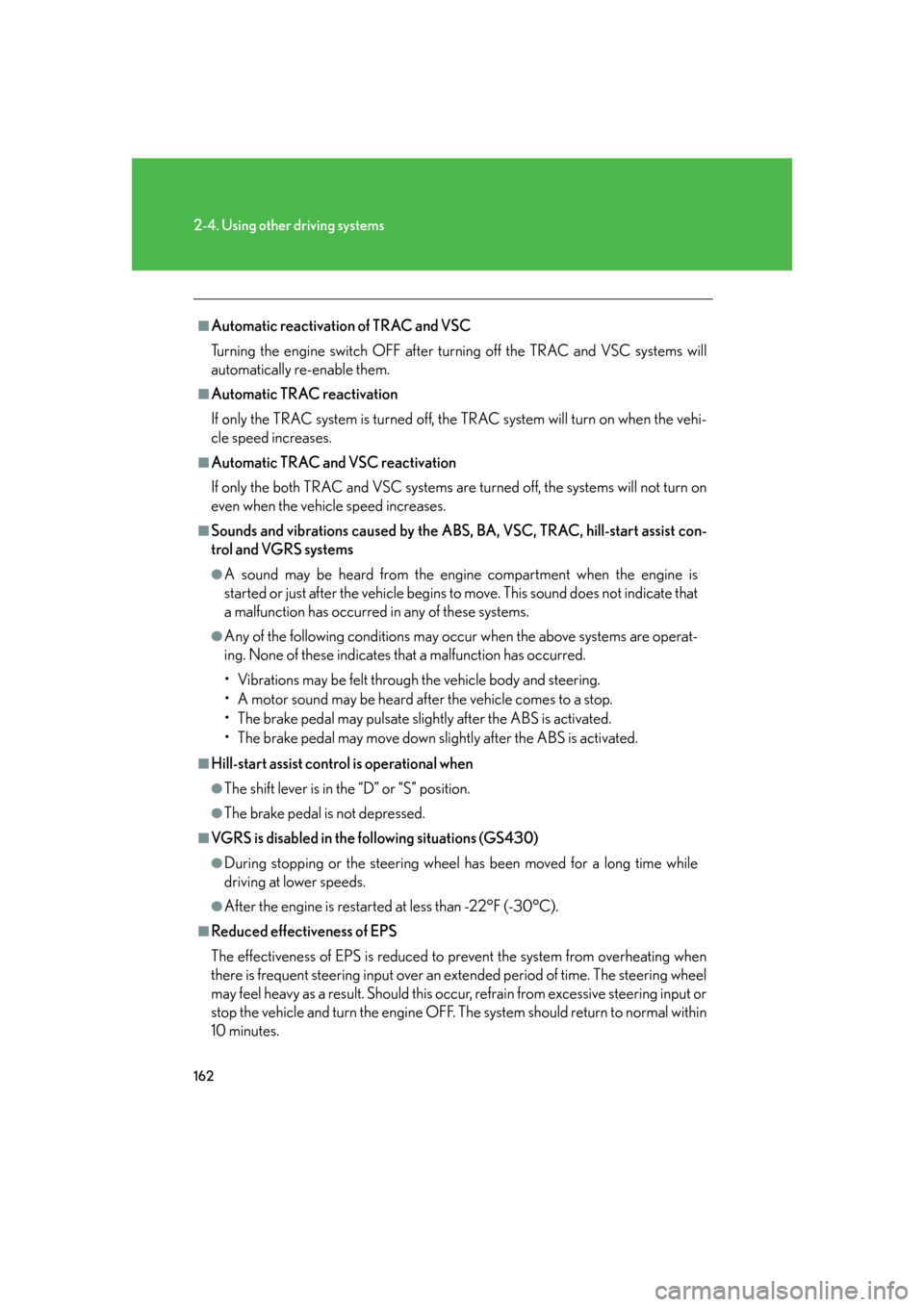
162
2-4. Using other driving systems
■Automatic reactivation of TRAC and VSC
Turning the engine switch OFF after turning of
f the TRAC and VSC systems will
automatically re-enable them.
■Automatic TRAC reactivation
If only the TRAC system is turned off, th e
TRAC system will turn on when the vehi-
cle speed increases.
■Automatic TRAC and VSC reactivation
If only the both TRAC and VSC systems are tur
ned off, the systems will not turn on
even when the vehicle speed increases.
■Sounds and vibrations caused by the ABS, BA, VSC, TRAC, hill-start assist con-
trol and VGRS systems
●A sound may be heard from the engine compartment when the engine is
started or just after the vehicle begins to move. This sound does not indicate that
a malfunction has occurred in any of these systems.
●Any of the following conditions may occur when the above systems are operat -
ing. None of these indicates that a malfunction has occurred.
• Vibrations may be felt through the vehicle body and steering.
• A motor sound may be heard after the vehicle comes to a stop.
• The brake pedal may pulsate slightly after the ABS is activated.
• The brake pedal may move down slightly af
ter the ABS is activated.
■Hill-start assist control is operational when
●The shift lever is in the “D” or “S” position.
●The brake pedal is not depressed.
■VGRS is disabled in the following situations (GS430)
●During stopping or the steering wheel has been moved for a long time while
driving at lower speeds.
●After the engine is restarted at less than -22°F (-30°C).
■Reduced effectiveness of EPS
The effectiveness of EPS is reduced to prevent the system from overheating when
th
ere is frequent steering input over an extended period of time. The steering wheel
may feel heavy as a result. Should this occur, refrain from excessive steering input or
stop the vehicle and turn the engine OFF. Th e system should return to normal within
10 minutes.
Page 186 of 562
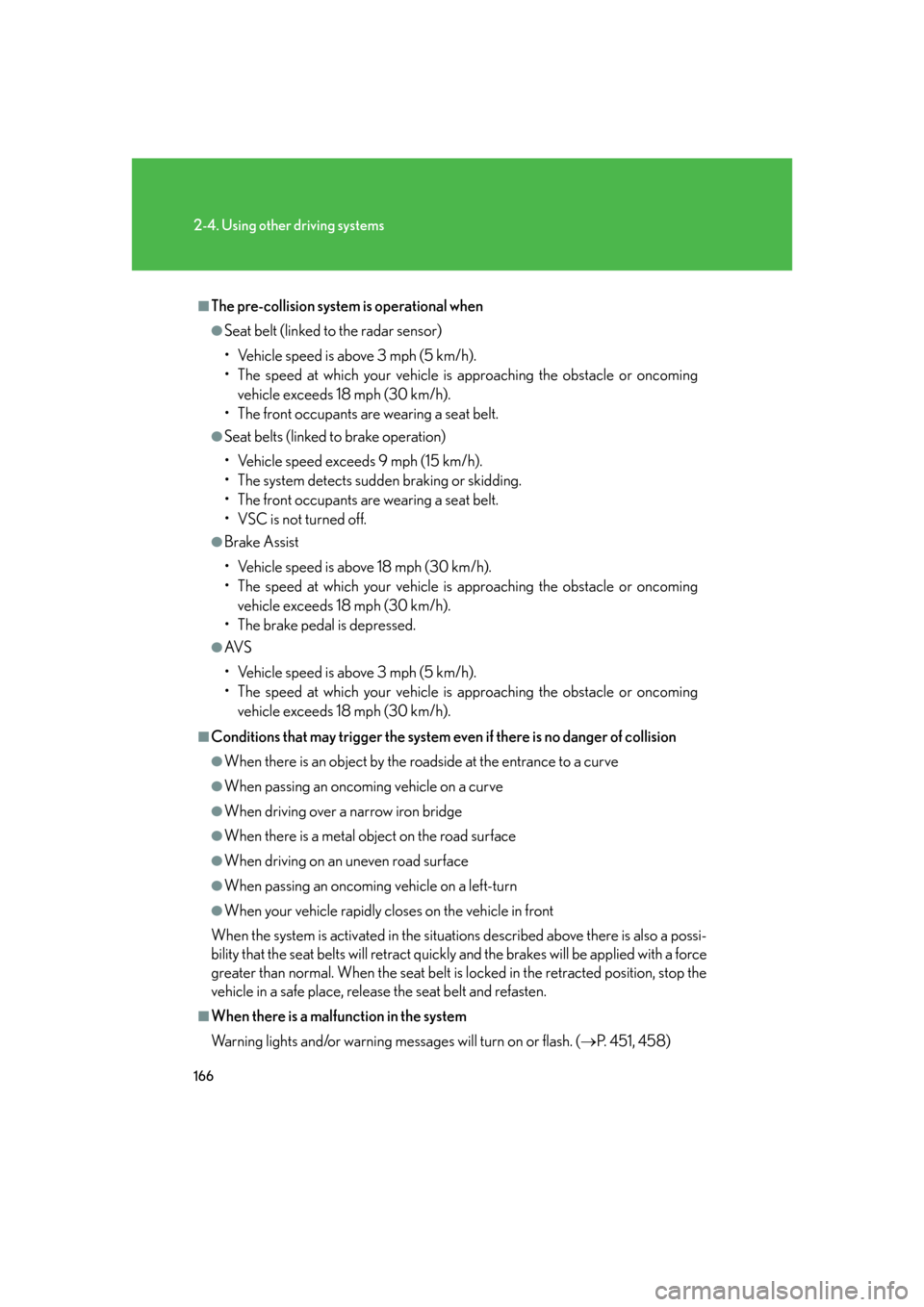
166
2-4. Using other driving systems
■The pre-collision system is operational when
●Seat belt (linked to the radar sensor)
• Vehicle speed is above 3 mph (5 km/h).
• The speed at which your vehicle is approaching the obstacle or oncoming vehicle exceeds 18 mph (30 km/h).
• The front occupants are wearing a seat belt.
●Seat belts (linked to brake operation)
• Vehicle speed exceeds 9 mph (15 km/h).
• The system detects sudd en braking or skidding.
• The front occupants are wearing a seat belt.
•VSC is not turned off.
●Brake Assist
• Vehicle speed is above 18 mph (30 km/h).
• The speed at which your vehicle is approaching the obstacle or oncoming vehicle exceeds 18 mph (30 km/h).
• The brake pedal is depressed.
●AV S
• Vehicle speed is above 3 mph (5 km/h).
• The speed at which your vehicle is approaching the obstacle or oncoming vehicle exceeds 18 mph (30 km/h).
■Conditions that may trigger the system even if there is no danger of collision
●When there is an object by the roadside at the entrance to a curve
●When passing an oncoming vehicle on a curve
●When driving over a narrow iron bridge
●When there is a metal object on the road surface
●When driving on an uneven road surface
●When passing an oncoming vehicle on a left-turn
●When your vehicle rapidly closes on the vehicle in front
When the system is activated in the situations described above there is also a possi-
bility that the seat belts will retract quickly and the brakes will be applied with a force
greater than normal. When the seat belt is locked in the retracted position, stop the
vehicle in a safe place, release the seat belt and refasten.
■When there is a malfunction in the system
Warning lights and/or warning messages will turn on or flash. ( P. 451, 458)